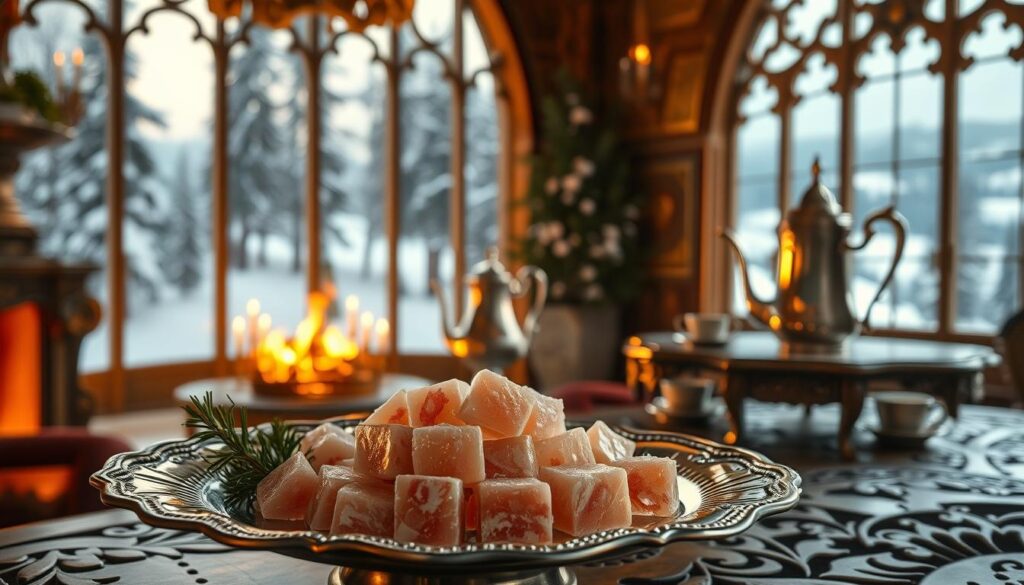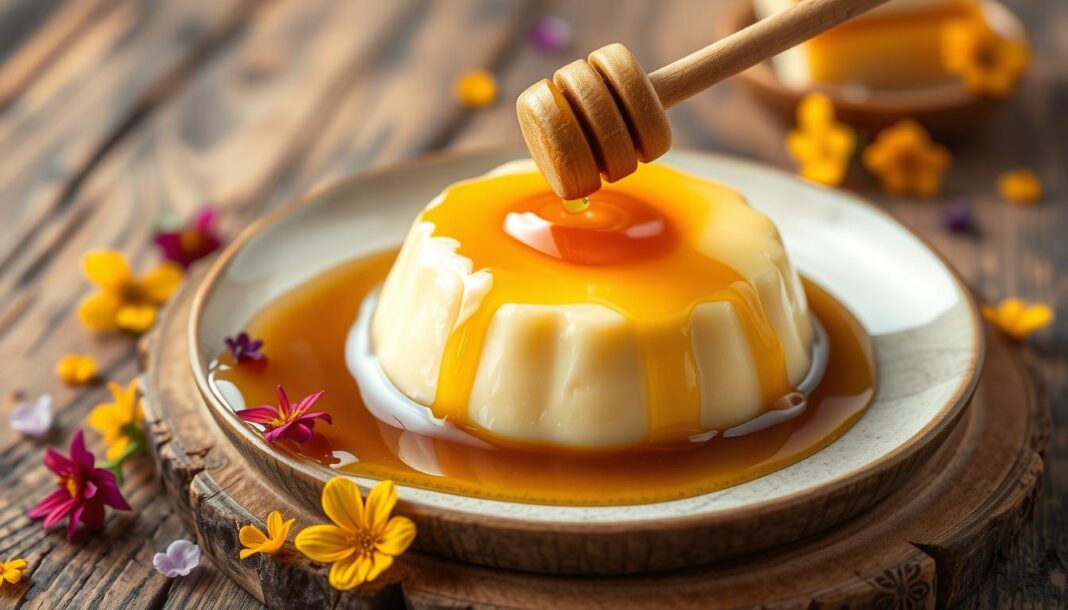C.S. Lewis’s “The Lion, the Witch and the Wardrobe” presents one of literature’s most memorable food moments with the iconic Turkish Delight. This sweet confection serves as both temptation and plot catalyst in the beloved Narnia series.
We explore how this simple candy becomes a powerful plot device, examining its significance beyond mere food. The historical context of candy during wartime rationing provides crucial background for understanding why Turkish Delight was such an effective temptation for Edmund.
Many readers experience the “Turkish Delight disappointment” when trying the candy for the first time after reading the book, creating a unique cultural phenomenon. Our examination will take you through the literary significance, historical context, and cultural impact of this sweet treat.
Key Takeaways
- Understanding the role of Turkish Delight in “The Lion, the Witch and the Wardrobe”
- Exploring the historical context of candy during wartime
- The cultural phenomenon of “Turkish Delight disappointment”
- The significance of food in literature
- How to make authentic Turkish Delight at home
The Significance of Candy in Narnia
The significance of candy in Narnia extends beyond mere indulgence, serving as a complex symbol within the story. In C.S. Lewis’s narrative, candy is intricately linked with the themes of temptation, greed, and the consequences of prioritizing personal desires over familial bonds.
Edmund’s Temptation and the White Witch’s Strategy
The White Witch uses Turkish Delight to tempt Edmund Pevensie, one of the four Pevensie children, into betraying his siblings. This enchanted candy is not just a simple bribe; it’s a tool of manipulation that exploits Edmund’s desires. The Queen’s magic makes the Turkish Delight horribly addictive, ensuring Edmund’s compliance. As Edmund “shovels” the candy into his mouth, he becomes increasingly enthralled, ultimately agreeing to bring his siblings to the White Witch in exchange for more of the confection.

Symbolism of Turkish Delight in the Narrative
Turkish Delight functions as a multi-layered symbol in Narnia, representing temptation, greed, and the consequences of Edmund’s actions. The exotic nature of the candy parallels the otherworldliness of Narnia, creating a sensory bridge between Edmund’s ordinary world and the magical realm. C.S. Lewis deliberately chose a luxurious and foreign confection to emphasize the extraordinary nature of Edmund’s temptation. The candy’s sweetness contrasts sharply with the bitter consequences of Edmund’s betrayal, creating a powerful juxtaposition that resonates throughout the story. For more insights on Turkish Delight in Narnia, visit our detailed analysis on Historical Foods.
| Symbolism | Description |
|---|---|
| Temptation | The allure of Turkish Delight tempts Edmund to betray his siblings. |
| Greed | Edmund’s desire for more Turkish Delight drives his actions. |
| Consequences | The bitter outcomes of Edmund’s betrayal contrast with the candy’s sweetness. |
Historical Context: Wartime Rationing and Sweet Treats
As World War II raged on, Britain implemented stringent rationing measures that impacted everyday life, including the availability of sweets. This historical context is crucial in understanding the narrative of C.S. Lewis’s The Lion, the Witch and the Wardrobe, where the temptation of Turkish Delight plays a pivotal role.
C.S. Lewis and the Reality of Sugar Rationing
C.S. Lewis, living through World War II, experienced firsthand the effects of sugar rationing. Sugar was scarce, and sweets were a rare luxury. This reality influenced Lewis’s choice of Turkish Delight as the candy that would tempt Edmund Pevensie. The scarcity of such sweets made them all the more desirable, adding to the believability of Edmund’s temptation.
Lewis’s own experiences during this period likely shaped his narrative, making the enchantment of Turkish Delight more relatable and the White Witch’s offer more compelling.
Why Turkish Delight Was the Perfect Choice for the Story
Turkish Delight was not a common sweet in mid-20th century Britain, making it exotic and luxurious. Its foreign origins and unique texture set it apart from other British sweets, much like Narnia itself was distinct from the ordinary world. The choice of Turkish Delight demonstrates Lewis’s attention to detail in crafting a narrative where even the smallest elements contribute to the overall atmosphere and themes.
| Characteristics of Turkish Delight | Relevance to Narnia |
|---|---|
| Exotic and luxurious | Symbolized otherworldly temptation |
| Foreign origins | Parallels Narnia’s difference from the ordinary world |
| Rarity during rationing | Enhanced believability of Edmund’s temptation |
What Is Turkish Delight? Understanding the Legendary Confection

Turkish Delight, a confection steeped in history and mystique, has captivated imaginations for centuries. This legendary treat, known as “lokum” in its homeland of Turkey, has been a subject of fascination for many, especially after its prominent feature in C.S. Lewis’s “The Lion, the Witch, and the Wardrobe.”
Origins and Traditional Preparation
Authentic Turkish Delight, or lokum, has its roots deeply embedded in Ottoman cuisine. Traditionally, it is made with cornstarch, sugar, and water, and often flavored with rosewater, lemon, or other natural essences. The preparation involves a meticulous process of boiling the sugar and water mixture to the correct temperature, then slowly incorporating the cornstarch mixture to achieve the signature gel-like texture. This traditional method allows for a delicate balance of flavors and textures that are characteristic of genuine lokum.
The Difference Between Authentic Lokum and Commercial Versions
The commercial “Turkish Delight” commonly found in Western countries, particularly in the UK and the USA, differs significantly from authentic lokum. Many commercial versions contain gelatin instead of cornstarch, resulting in a different texture and mouthfeel. Additionally, artificial flavorings are often used, which can give the confection a medicinal taste that is unappealing to those accustomed to traditional lokum. In contrast, authentic lokum is made in small batches with fresh ingredients, ensuring a high-quality product with rich, natural flavors.
The disconnect between the authentic lokum and its commercial counterparts explains the “Turkish Delight disappointment” phenomenon experienced by many fans of “The Lion, the Witch, and the Wardrobe” when they finally try the candy described in the book. Understanding the differences between authentic and commercial Turkish Delight can enhance appreciation for this traditional confection and encourage those interested to seek out the genuine article.
How to Make Authentic Narnian Turkish Delight at Home

Creating authentic Narnian Turkish Delight at home is a delightful journey into the world of C.S. Lewis’s beloved fantasy series. For those enchanted by the magical land of Narnia, this traditional confectionery offers a tangible connection to the narrative’s rich textures and tastes.
Ingredients and Equipment Needed
To embark on this culinary adventure, you’ll need a few key ingredients and some specialized equipment. The core components include granulated sugar, cornstarch, and water, along with flavorings such as rose water or lemon juice. A candy thermometer is crucial for achieving the precise temperature required for the perfect Turkish Delight.
Step-by-Step Preparation Process
Begin by preparing a cornstarch slurry, which you’ll slowly pour into a hot syrup, whisking continuously to avoid lumps. Keep It Slow and Steady: this is crucial for a smooth texture. As you cook the mixture, Consistency is Key; regular stirring prevents sticking and ensures an even consistency. Temperature Accuracy is also vital; aim for exactly 250°F to achieve the right set and texture.
For a more detailed guide on preparing Turkish Delight, you can refer to this recipe that shares insights into the traditional method.
Tips for Perfect Results
To ensure your Turkish Delight turns out perfectly, several tips are worth keeping in mind. Firstly, allow the lokum to set at room temperature for 5-10 hours; refrigeration can cause condensation, ruining the texture. When cutting the set lokum into pieces, dust your knife with cornstarch to prevent sticking. Finally, Proper Storage involves keeping the Turkish Delights in an airtight container with plenty of powdered sugar to maintain their coating.
The Cultural Impact of Candy in Narnia
Through the lens of Narnia, C.S. Lewis not only told a compelling story but also shed light on the cultural significance of Turkish Delight. The Chronicles of Narnia series has profoundly influenced how we perceive and interact with certain candies, particularly Turkish Delight.
From Book to Screen: How Turkish Delight Was Portrayed
The transition of Turkish Delight from the pages of C.S. Lewis’s novels to the screen has been a fascinating journey. In the 2005 film adaptation of “The Lion, the Witch and the Wardrobe,” Turkish Delight was visually represented, bringing the White Witch’s tempting offer to life. This portrayal not only captivated audiences but also reignited interest in the candy. However, the on-screen representation often differed significantly from the authentic Turkish lokum, leading to a disconnect between viewers’ expectations and the reality of the candy.
We observe that the film adaptations played a crucial role in popularizing Turkish Delight, making it a topic of discussion among both fans of the book and newcomers to the Narnia series.
The “Turkish Delight Disappointment” Phenomenon
The “Turkish Delight Disappointment” refers to the widespread experience of readers who, after being enticed by C.S. Lewis’s descriptions, finally tried the candy only to find it didn’t live up to their expectations. This phenomenon is largely attributed to the difference between authentic Turkish lokum and the mass-produced versions commonly available in Western countries.
Many first-time tasters expect an intensely sweet, familiar candy experience but instead encounter unfamiliar floral flavors or unusual textures. This disparity reveals how food experiences are culturally conditioned, and how our expectations of deliciousness are shaped by our culinary backgrounds.
| Aspect | Authentic Turkish Lokum | Mass-Produced Turkish Delight |
|---|---|---|
| Flavor Profile | Often features floral notes like rosewater or lemon | Typically intensely sweet, sometimes with artificial flavorings |
| Texture | Soft, gel-like, and often coated with powdered sugar | Can be firmer, sometimes with added textures or coatings |
| Cultural Experience | Part of traditional Turkish cuisine, enjoyed in its cultural context | Often consumed as a novelty or based on literary/film references |
Bringing the Magic of Narnia to Your Kitchen
Recreating Turkish Delight from scratch allows us to relive the magic of Narnia, where the boundaries between reality and fantasy blur. As we conclude our journey into the world of C.S. Lewis’s creation, we can now bring this iconic candy into our kitchens. The process of makingTurkish Delightconnects us to both the magical world of Narnia and the historical context of wartime Britain, where sugar was rationed and such treats were rare luxuries.
To achieve the perfectTurkish Delight, we dust the set lokum with cornstarch and cut it into bite-sized squares. Then, we coat each piece generously with powderedsugar, creating a visual effect reminiscent of the snow-covered world of Narnia under the White Witch’s spell. Storing theTurkish Delightsin an airtight container filled with powderedsugarand cornstarch maintains their soft, chewy texture.
By sharing our homemadeTurkish Delightwith family and friends, we create an opportunity to discuss the book’s themes of temptation and redemption, bringing the magic of Narnia into our kitchens. The time invested in making this specialcandyfrom scratch makes the final result all the more rewarding. As we enjoy our delicious creations within 72 hours, we experience a taste of Narnia and a deeper connection to the beloved story.


